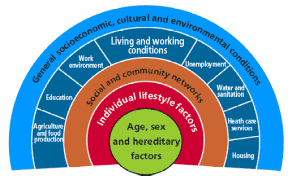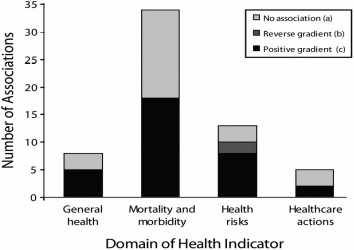Thesis statement
A case study carried out in Australia gives a clear picture of how health determinants impact the lives of individuals. This study considered the relationships between the health determinants, the choices that people make, and the affected populations. The study identified the general health determinants, the impact of the social gradient between the health of indigenous and non-indigenous populations, and justifications and conclusions provided for the findings. The findings in the study would be very useful in searching an individual’s spirit to evaluate the choices made. However, the factors that influence the choices people make would be useful in determining health risks to people. Therefore, this discussion addresses the aspects of poor health and the determinants of health in society.
A broad discussion of the determinants of health which may shape people’s health
Social gradients
Social class has received both positive and negative impacts on the health of every person. Cockerham (2007) argues that social rank can be associated with the capability of a person to handle stress. He added that a person in a higher social rank deals properly with the prevailing or upcoming situation (Cockerham, 2007). Therefore, the health of a person and his or her decisions face influence from the poor social gradient that exists in the society.
Unemployment
Over the years, the decisions that people make are influenced by their financial status. Unemployment has placed people’s health at a higher risk of contracting serious diseases that arise due to the decisions influenced by this factor (Rickles, Wertheimer & Smith, 2010). Due to unemployment, a person can face social challenges that may make him or her make poor decisions affecting personal life.
Development during early life
The early development of people influences the character of an individual in the future life. In every society, the healthy life of every adult has been linked to his or her early life (Rickles et al., 2010). Any child who is subjected to poor health is believed to have wretched health conditions after becoming an adult.
Social exclusion
The health of a person is dependent entirely on the social exclusion of society. In Australia, marginalization has been evident on several occasions. This exclusion is in the form of social disadvantage as well as the lowering of rank to the edge of society (Rickles et al., 2010). In Australia, the social exclusion that has been apparent includes racism, and the discrimination between indigenous and non-indigenous citizens (Amanda & Siobhan, 2012). Social exclusion leads to imbalances in the access to decent housing, good transportation, and education which affect the health of a person.
Social support
Social support refers to the perception of how much a person is cared for by other people and the certainty to form part of a supportive network in society. Social support is depicted in advice obtained from financial support and emotional assistance existing between people living in a society (Rickles et al., 2010). It influences different decisions that people make in society. In Australia, social support forms a major basis in the coexistence of people within the rural and urban areas.
Availability of food
The health of a person has a significant link with the diet one engages in. The quality of food taken determines the health of a person. Diseases and disorders associated with poor health in Australia include diabetes, obesity especially in adolescence, and cancer among others. All the health problems that arise from food are within people’s control to some degree. The only understandable exceptions are in the cases of poor people who have no options on the diet to follow.
Other health determinants
- Work. The work performed by a person influences the diseases that attack him or her some times. For example, those who work in chemical industries are bound to suffer from respiratory diseases in Australia.
- Physical environment. The quality of water that is available for drinking, safe housing, and clean air to breathe have got an impact on the health of a person.
Conclusively, the health determinants can be blamed on the bad health of an individual. However, since these factors are influenced majorly by man’s activities, people have the right to choose the life to lead and ensure good health.
Outline for the social gradient and how it relates to indigenous and non-indigenous Australians
The correlation between indigenous and non-indigenous Australians as well as how social gradient influenced the health of the chosen group was considered. Concerning the social model of health, social gradient plays a major role in health. This correlation affects the social modernity of health in terms of people’s lifespan, the economic status of the two groups, and their lifestyles. The diagram below shows the social model of health determinants:

There are various researches performed by researchers to evaluate the health conditions of people living in Australia. Recent research conducted in Australia indicates that indigenous people have poorer health when compared to non-indigenous ones (Carrington, Jianghong & Stephen, 2012). Carrington et al. (2012) found that socioeconomic variables explain the inequalities in health status between the indigenous and non-indigenous Australians properly. In Australia, there is a rift between the health of indigenous and non-indigenous individuals to access education, income, and employment.
Education
Education is another determinant of the life attained by people because employment is based on education. In 2011, 1.6 percent of all non-indigenous people did not attend school. The non-indigenous individuals comprised 0.9 percent of the overall count (Social and Emotional Wellbeing, 2012). A higher level of education among non-indigenous Australians positively influences their health. High education standards result in a more secure job, which in turn leads to better living standards among non-indigenous populations (Amanda & Siobhan, 2012). Therefore, the social gradient can be seen in terms of the significant difference between the educational standards between the two groups.
Employment
The ability to secure a job that can sustain an individual and his or her family is imperative. There is a higher percentage of the employed non-indigenous compared to the indigenous (Social and Emotional wellbeing, 2012). A high number of non-indigenous employees results in their elevated standards of living and, therefore, better living conditions among the non-indigenous populations. The high number of unemployment cases present among the non-indigenous population results in a significant difference between the two groups. The difference is in terms of the life span of adult indigenous groups and the choices that they make hence, the palpable influence by the social gradient. The choices that the non-indigenous populations make will favor their health development.
Income
The higher income earned by the non-indigenous communities enables them to make proper choices that little endanger their health. In 2011, gross household income for Indigenous persons was estimated to be around $475 per week compared to $800 for non-Indigenous persons (Social and Emotional wellbeing, 2012). This significant difference in economic status between the two populations puts them into a distinct social class. Since the indigenous populations have lower incomes, they are bound to experience various economic problems which will affect their health as compared to that of the non-indigenous community.
Health risks
People who manage to take good health during their life have a higher chance of surviving most diseases. Among the health risks associated with the social gradient include general health of the communities, gastrointestinal infections, long-term diseases, diabetes, mental circulatory diseases, and kidney diseases (Carrington et al., 2012). In Australia, it has been observed that there exists a significant gap between the health status of the non-indigenous and the indigenous communities (Carrington et al., 2012). Indigenous populations are prone to health risks due to their low socio-economic status as compared to that of the non-indigenous populations (Carrington et al., 2012). The social class that is significant among these two groups puts the indigenous population to be at a higher ladder in contracting the diseases characterized by the social gradient.
In Australia, there is an association pattern identified between the health fitness of the two groups being considered. The World Health Organization estimated that the life anticipation at delivery within the indigenous people was significantly lower than those of the non-indigenous populations. The estimates were 59.4% for the males and 64.8% for the female indigenous as compared to the 76.6% for the males and 82.0% for the non-indigenous female (Commission on Social Determinants of Health, 2008).

There is a significant difference between the extent to which mental illness and other mental health problems exist between indigenous and non-indigenous communities in Australia. The prevalence of mental disorders was higher among the indigenous (79%) as compared to the non-indigenous (Social and Emotional wellbeing, 2012).
Conclusively, the non-indigenous communities are usually more financially stable, educated, and do not suffer highly from the social gradient compared to the indigenous people. This difference brings about the health inequalities and social gradient that influence the health conditions between the two groups (Health inequalities, n.d.).
Conclusion
In Australia, the choices that people make were influenced by social gradient, unemployment, individual development during early life, availability of food, social exclusion, social support, and the occupation of an individual. However, social gradients were established to have more weight on the choices that the Australians make. This was exemplified by the contrast drawn between the health of indigenous and non-indigenous communities. The better health of the non-indigenous Australians was attributed to the prevailing health determinants which favor them as compared to the indigenous populations.
References
Amanda, D., & Siobhan, H., (2012). A Healthy Tasmania: Setting New Directions for Health and Wellbeing. Web.
Carrington, C., Jianghong, L., & Stephen, R., (2012). Social Gradients in the Health of Indigenous Australians. The American Public Health association, 102(1), 107–117.
Cockerham, W., (2007). Social causes of health and disease. Cambridge: Polity.
Commission on Social Determinants of Health. (2008). Web.
Health inequalities. (n.d.). Web.
Rickles, N., Wertheimer, A., & Smith, M. (2010). Social and behavioral aspects of pharmaceutical care. Sudbury, Mass: Jones and Bartlett Publishers.
Social and Emotional Wellbeing. (2012). Web.
World Health Organization. (1948). Web.